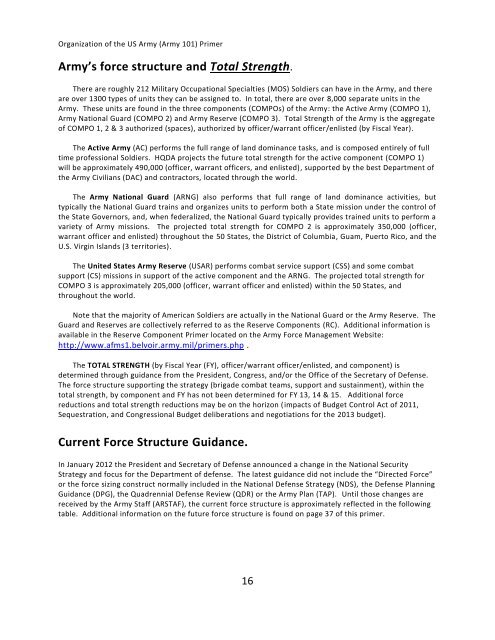An Overview of Army structure and capabilities - Force Management ...
An Overview of Army structure and capabilities - Force Management ...
An Overview of Army structure and capabilities - Force Management ...
Create successful ePaper yourself
Turn your PDF publications into a flip-book with our unique Google optimized e-Paper software.
Organization <strong>of</strong> the US <strong>Army</strong> (<strong>Army</strong> 101) Primer<br />
<strong>Army</strong>’s force <strong>structure</strong> <strong>and</strong> Total Strength.<br />
There are roughly 212 Military Occupational Specialties (MOS) Soldiers can have in the <strong>Army</strong>, <strong>and</strong> there<br />
are over 1300 types <strong>of</strong> units they can be assigned to. In total, there are over 8,000 separate units in the<br />
<strong>Army</strong>. These units are found in the three components (COMPOs) <strong>of</strong> the <strong>Army</strong>: the Active <strong>Army</strong> (COMPO 1),<br />
<strong>Army</strong> National Guard (COMPO 2) <strong>and</strong> <strong>Army</strong> Reserve (COMPO 3). Total Strength <strong>of</strong> the <strong>Army</strong> is the aggregate<br />
<strong>of</strong> COMPO 1, 2 & 3 authorized (spaces), authorized by <strong>of</strong>ficer/warrant <strong>of</strong>ficer/enlisted (by Fiscal Year).<br />
The Active <strong>Army</strong> (AC) performs the full range <strong>of</strong> l<strong>and</strong> dominance tasks, <strong>and</strong> is composed entirely <strong>of</strong> full<br />
time pr<strong>of</strong>essional Soldiers. HQDA projects the future total strength for the active component (COMPO 1)<br />
will be approximately 490,000 (<strong>of</strong>ficer, warrant <strong>of</strong>ficers, <strong>and</strong> enlisted), supported by the best Department <strong>of</strong><br />
the <strong>Army</strong> Civilians (DAC) <strong>and</strong> contractors, located through the world.<br />
The <strong>Army</strong> National Guard (ARNG) also performs that full range <strong>of</strong> l<strong>and</strong> dominance activities, but<br />
typically the National Guard trains <strong>and</strong> organizes units to perform both a State mission under the control <strong>of</strong><br />
the State Governors, <strong>and</strong>, when federalized, the National Guard typically provides trained units to perform a<br />
variety <strong>of</strong> <strong>Army</strong> missions. The projected total strength for COMPO 2 is approximately 350,000 (<strong>of</strong>ficer,<br />
warrant <strong>of</strong>ficer <strong>and</strong> enlisted) throughout the 50 States, the District <strong>of</strong> Columbia, Guam, Puerto Rico, <strong>and</strong> the<br />
U.S. Virgin Isl<strong>and</strong>s (3 territories).<br />
The United States <strong>Army</strong> Reserve (USAR) performs combat service support (CSS) <strong>and</strong> some combat<br />
support (CS) missions in support <strong>of</strong> the active component <strong>and</strong> the ARNG. The projected total strength for<br />
COMPO 3 is approximately 205,000 (<strong>of</strong>ficer, warrant <strong>of</strong>ficer <strong>and</strong> enlisted) within the 50 States, <strong>and</strong><br />
throughout the world.<br />
Note that the majority <strong>of</strong> American Soldiers are actually in the National Guard or the <strong>Army</strong> Reserve. The<br />
Guard <strong>and</strong> Reserves are collectively referred to as the Reserve Components (RC). Additional information is<br />
available in the Reserve Component Primer located on the <strong>Army</strong> <strong>Force</strong> <strong>Management</strong> Website:<br />
http://www.afms1.belvoir.army.mil/primers.php .<br />
The TOTAL STRENGTH (by Fiscal Year (FY), <strong>of</strong>ficer/warrant <strong>of</strong>ficer/enlisted, <strong>and</strong> component) is<br />
determined through guidance from the President, Congress, <strong>and</strong>/or the Office <strong>of</strong> the Secretary <strong>of</strong> Defense.<br />
The force <strong>structure</strong> supporting the strategy (brigade combat teams, support <strong>and</strong> sustainment), within the<br />
total strength, by component <strong>and</strong> FY has not been determined for FY 13, 14 & 15. Additional force<br />
reductions <strong>and</strong> total strength reductions may be on the horizon (impacts <strong>of</strong> Budget Control Act <strong>of</strong> 2011,<br />
Sequestration, <strong>and</strong> Congressional Budget deliberations <strong>and</strong> negotiations for the 2013 budget).<br />
Current <strong>Force</strong> Structure Guidance.<br />
In January 2012 the President <strong>and</strong> Secretary <strong>of</strong> Defense announced a change in the National Security<br />
Strategy <strong>and</strong> focus for the Department <strong>of</strong> defense. The latest guidance did not include the “Directed <strong>Force</strong>”<br />
or the force sizing construct normally included in the National Defense Strategy (NDS), the Defense Planning<br />
Guidance (DPG), the Quadrennial Defense Review (QDR) or the <strong>Army</strong> Plan (TAP). Until those changes are<br />
received by the <strong>Army</strong> Staff (ARSTAF), the current force <strong>structure</strong> is approximately reflected in the following<br />
table. Additional information on the future force <strong>structure</strong> is found on page 37 <strong>of</strong> this primer.<br />
16


